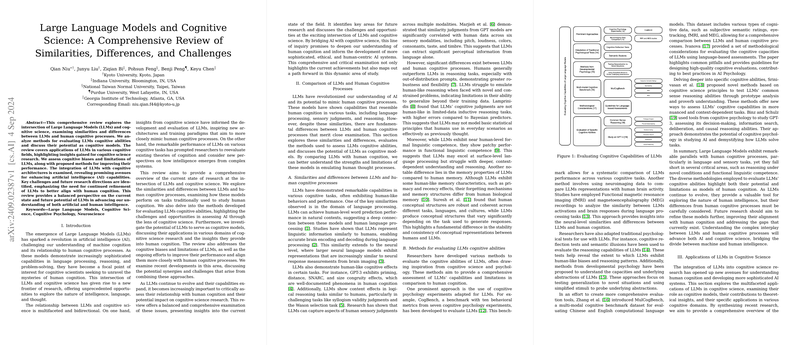LLMs and Cognitive Science: A Comprehensive Review
The paper "LLMs and Cognitive Science: A Comprehensive Review of Similarities, Differences, and Challenges" by Qian Niu et al. explores the intersections between LLMs and cognitive science, focusing on the parallels and discrepancies between these models and human cognitive processes. This review comprehensively examines the methodologies for evaluating LLMs, and discusses their applications in cognitive fields, their biases, and limitations, and the prospects of integrating LLMs with cognitive architectures. As such, this paper provides essential insights into the current state of LLMs and their potential contribution to both AI development and cognitive science research.
Similarities and Differences Between LLMs and Human Cognitive Processes
LLMs exhibit significant capabilities that mirror human cognitive functions, particularly in language processing. They have achieved human-level word prediction performance in natural contexts and have demonstrated similar neural representations to those seen in human brain imaging studies. Specific human-like cognitive effects such as priming, distance effects, and sensory judgments across modalities have been observed in LLMs. For example, studies showing that LLMs like GPT-3 can replicate content effects in logical reasoning tasks point towards an inherent similarity in processing language and contextual information. Such parallels underscore the deep, although not perfect, alignment with human cognitive phenomena.
However, LLMs have notable limitations, especially in tasks requiring robust and flexible reasoning. Human cognition generally outperforms LLMs in novel problem-solving contexts, emphasizing the models' reliance on pre-existing data rather than the dynamic problem-solving capabilities inherent in human thought. Furthermore, while LLMs can exhibit near-human levels of formal linguistic competence, they struggle with functional linguistic competence, which involves context-specific understanding and reasoning. Significant differences in memory properties and semantic stability between LLMs and humans also indicate that while LLMs can mimic certain cognitive attributes, they do not fully replicate human cognitive processes.
Methods for Evaluating LLMs' Cognitive Abilities
To comprehensively assess LLMs’ cognitive abilities, multiple methodologies have been developed. Adaptations of cognitive psychology experiments such as CogBench, which includes behavioral metrics from cognitive psychology, enable systematic comparisons. Utilizing neuroimaging data to compare LLMs' neural activations with human brain responses offers insights into their cognitive processing similarities. Traditional psychological tests, developmental psychology paradigms, and novel methods based on cognitive science principles further contribute to the robust evaluation of LLMs’ cognitive functionalities.
These diverse evaluation methodologies highlight both the potential and limitations of LLMs as cognitive models. Importantly, studies like those involving Representational Similarity Analysis (RSA) reveal that factors such as model scaling and training data size significantly influence the alignment between LLMs and human brain activity, suggesting areas for further improvement and alignment.
Applications of LLMs in Cognitive Science
LLMs serve as cognitive models, potentially offering precise representations of human behavior and outperforming traditional models in some decision-making tasks. Their role extends to generating context-sensitive translations, supporting commonsense reasoning, and aligning predictive processing with neural and behavioral data in human language processing. Additionally, applications in fields such as lexical semantics and causal reasoning demonstrate LLMs' ability to model complex cognitive functions.
However, the integration of LLMs into cognitive science is not without contention. Skepticism persists regarding the deep cognitive abstractions captured by LLMs, raising questions about their true cognitive understanding and capability. The application of LLMs must be underscored with a nuanced understanding of their limitations and the necessity for rigorous empirical testing.
Cognitive Biases and Limitations
LLMs exhibit cognitive biases similar to humans, including overconfidence, framing effects, and surface-level understanding of concepts. Recent studies have highlighted such biases, advocating for awareness and strategies to mitigate these biases in AI applications. While these biases present challenges, they also offer opportunities to paper cognitive biases in controlled environments, thus contributing to the broader understanding of human cognition.
Methods for Improving LLMs
To mitigate biases and enhance performance, several methods have been proposed. These include models that improve language understanding through reinforcement learning, iterative cognitive mechanisms, and enhancing interpretative strategies with insights from human cognitive processes. Addressing these biases and limitations will be crucial to refining LLMs and improving their alignment with human cognitive processes.
Integration with Cognitive Architectures
Integrating LLMs with cognitive architectures can enhance cognitive performance by leveraging the strengths of both approaches. Research has demonstrated that such integration could improve reasoning capabilities, human-robot interaction, and personalized search results in specialized domains. Challenges remain in ensuring knowledge accuracy, managing computational costs, and addressing the inherent limitations.
Conclusion
The intersection of LLMs and cognitive science reveals exciting possibilities for advancing both artificial and human understanding of intelligence. The paper provides a balanced examination of LLMs' capabilities, highlighting their profound similarities with human cognition while clearly addressing their limitations. Future research should focus on refining LLMs, mitigating their biases, and enhancing their adaptability to novel problem-solving scenarios. By doing so, LLMs could serve not only as sophisticated AI systems but also as invaluable tools in cognitive science, offering deeper insights into the essence of human cognition.
